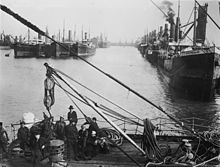Cardiff Docks
| Port of Cardiff | |
|---|---|
UK | |
| Location | Cardiff, Wales |
| Coordinates | 51°27′55″N 3°09′14″W / 51.46533°N 3.15382°W |
| Details | |
| Opened | 1839 |
| Owned by | Associated British Ports |
| Type of harbour | Artificial |
| Size | 852 acres (345 ha) |
| No. of berths | 25 |
| Statistics | |
| Annual cargo tonnage | 2.5 million tonnes[1] |
| Website southwalesports | |
Cardiff Docks (
History

Following the development of the coal found in the
In 1794, the Glamorganshire Canal was completed, linking the then small town of Cardiff with Merthyr, and in 1798 a basin was built, connecting the canal to the sea. By the 1830s, Cardiff became the pre-eminent iron-exporting port, shipping almost half of British overseas iron exports; between 1840 and 1870, the volume of coal exports increased from 44,350 to 2.219 million tonnes.[2]

Bute Docks
Increasing agitation for proper dock facilities led Cardiff's foremost landowner,
With the construction of the new East Bute Dock from 1855, designed by James Walker[4] of Messrs. Walker & Burges and built by Thomas Cubitt's firm,[5] its opening in 1859 resulted in coal supplanting iron as the industrial foundation of South Wales, with exports reaching 2 million tons as early as 1862.
The Bute Docks Feeder supplied the East Bute Dock with water extracted from the River Taff at Blackweir in Maindy, and now supplies the Roath Dock. It is largely an open canal through central Cardiff, other than a culvert between the New Theatre and the Cardiff International Arena.[6]
Queen Alexandra Dock
Frustration at the lack of development at Cardiff led to rival docks being opened at
These developments eventually spurred Cardiff into action, with the opening of the Roath Dock in 1887, and the Queen Alexandra Dock in 1907. By then, coal exports from the
Shipping
Cardiff's first steamship was the Llandaff of 1865, and by 1910, there were some 250 tramp steamers owned at Cardiff, by prominent firms such as
Railways
The Taff Vale Railway was built to transport coal from the South Wales Valleys to the docks. Its headquarters were a currently derelict building in Cardiff Bay railway station. The building was turned into a railway heritage centre in 1979 by the Butetown Historic Railway Society. By 1994 the Society had started to run steam locomotive hauled passenger services up and down 550 yards of track. However, as the Cardiff Bay Development Corporation had no interest in the railway, the society changed its name to the Vale of Glamorgan Railway and moved from the site in 1997 to Barry Island railway station.
Decline

From 1910 onwards capacity issues meant that the more modern and less tidal
Modern port facilities

Cardiff now has three operational docks capable of handling ships of up to 35,000 tons
Tiger Bay
Tiger Bay was a local nickname for the general Cardiff Docks area, the evocative phrase deriving from the area's rough-and-tumble reputation. Merchant seamen arrived in Cardiff from all over the world, only staying for as long as it took to discharge and reload their ships: consequently many murders and lesser crimes went unsolved and unpunished, the perpetrators having sailed for other ports. In Victorian times, the name "Tiger Bay" was used in popular literature and slang (especially that of sailors) to denote any dock or seaside neighbourhood which shared a similar notoriety for danger.[13]
Cardiff Bay
The
Only two docks, the Roath and the Queen Alexandra, remain in use, and just two shipping companies remain, albeit buoyant with their worldwide interests. Shipping movements varying from a couple of movements to 10 or 12 per tide, with trade in timber, oil, scrap and containers.
See also
References
- ^ "Cardiff – UK Ports – The comprehensive guide to the UK's Ports". uk-ports.org. Archived from the original on 5 May 2016. Retrieved 27 April 2018.
- ^ a b c The Welsh Academy Encyclopedia of Wales. Cardiff: University of Wales Press 2008.
- ^ "Cardiff – Associated British Ports". Associated British Ports. Archived from the original on 2 October 2015.
- ^ "Grace's Guide British Industrial History". Archived from the original on 13 January 2013.
- ^ Holland & Hannen and Cubitts – The Inception and Development of a Great Building Firm, published 1920, Page 51
- ^ "Bute Docks Feeder, Cardiff (34240)". Coflein. RCAHMW.
- ^ "Cardiff Port Plan". ABP South Wales Ports. ABP. Archived from the original on 19 April 2016. Retrieved 9 April 2016.
- ^ "Cardiff Docks" (PDF). ABP South Wales Ports. ABP. Archived (PDF) from the original on 19 April 2016. Retrieved 9 April 2016.
- ^ "Britannia Quay, Roath Basin, Cardiff". ABP South Wales Ports. ABP. Archived from the original on 19 April 2016. Retrieved 9 April 2016.
- ^ "Port of Cardiff". ABP South Wales Ports. ABP. Archived from the original on 19 April 2016. Retrieved 9 April 2016.
- ^ "Cardiff". Cargo Services UK Ltd. Archived from the original on 19 April 2016. Retrieved 9 April 2016.
- ^ "Victorian London – Districts – Streets – Bluegate Fields [article by reader of www.victorianlondon.org]". www.victorianlondon.org. Archived from the original on 3 March 2016. Retrieved 27 April 2018.
Further reading
- "Cardiff – Coal and Shipping Metropolis" By Dr David Jenkins, National Museums & Galleries of Wales. Published: 3 May 2005
- Cardiff and its port facilities by H.E.Roese, published 1995 in Morgannwg, Vol.XXXIX, pp. 50–71


